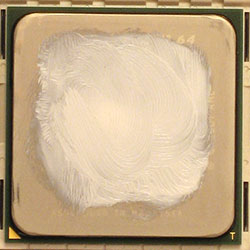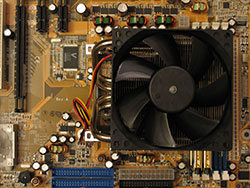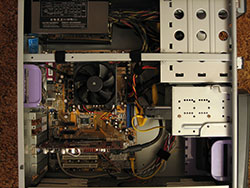Investigations into Socket 939 Athlon 64 Overclocking
by Jarred Walton on October 3, 2005 4:35 PM EST- Posted in
- CPUs
System Assembly
Once you have all the parts, it's time to put everything together. We're going to assume that you know the basic process, but here's our order for assembling a new system.
With the system up and running, install the OS and drivers. We use SATA drives almost exclusively for new PCs, which is why it's important to check the BIOS settings. Installing XP and the drivers is pretty simple, so we're not going to go into much detail. Use your CD and key, and then when XP is installed, you use the driver CD that comes with your motherboard. That will get you network, sound, and chipset drivers. You might want to check for newer versions online once you have networking installed, or else download them in advance on another PC and copy them to the new system. We also grab all the latest Windows Updates for any system with Internet access, though not necessarily for performance testing. Since we're only using one board, we installed all the Windows Updates along with a bunch of other software that we'll use in benchmarking. We also recommend switching your SATA hard drive to port 3 or 4 (or one of the extra ports) once Windows is installed. SATA ports 1 and 2 generally don't behave well when you begin overclocking beyond a certain threshold, and with the drivers installed, Windows should boot fine whether your primary drive is connected to port 1 or 3 or something else.
You'll note that up to this point, we haven't even talked about overclocking our new system. If you don't realize this already, let's make this clear: get your OS installed and running and test all your programs before you start overclocking! Setting up a new PC is a complex process, and even experienced system builders encounter problems. You don't want to have the Windows XP install program crash at 95% complete due to an overclock. It's not nearly as bad to have the system crash once you have it working, which is why we say to wait. Even then, it is possible to have an overclocked system crash and corrupt files, forcing you to reinstall applications or even XP from scratch. (It happened at least once in my testing, though not with socket 939.) There's a risk, but for many, the potential rewards outweigh the risk.
Once you have all the parts, it's time to put everything together. We're going to assume that you know the basic process, but here's our order for assembling a new system.
- Remove all components from boxes and lay them out on the workbench in an orderly fashion. (Check for order errors.)
- Install the CPU into the motherboard socket with the motherboard resting on the padded foam cushion with which it shipped.
- Apply a small amount of thermal paste to the center of the CPU heat spreader, then smooth it out a bit using your finger, a razor blade, etc. The idea is to get a thin layer on the heat sink, and you don't need to cover the whole CPU surface; once the HSF is installed, the thermal grease will flatten out to cover the rest of the CPU surface and you don't want a lot of extra grease. (Technically, AMD voids your CPU warranty if you don't use approved thermal grease. We've never had to deal with a failed Athlon 64 chip yet, so we can't comment on how they would respond. Overclocking is already voiding the warranty, so we're not worried about "approved" thermal compounds.)
- Install the heat sink onto the CPU - carefully. Depending on which HSF that you decide to purchase, you may need to change the mounting bracket, back plate, etc. One of the reasons why we like the Thermalright HSF is because you don't need to change the back plate (which is sometimes "glued" onto the motherboard). Don't forget to connect the fan to the 3-pin CPU header on the motherboard.
- Install the RAM into the appropriate slots. For the DFI board, that would be slots 3 and 4 (the two closest to the CPU). Other manufacturers number their slots differently and may separate the RAM for dual channel operation. Read the manual for your motherboard.
- If your case doesn't already have the power supply installed, it's generally best to install that now. Otherwise, the HSF for the CPU can get in the way. This varies by case, of course, but we almost always find it easier to get the PSU in before anything else.
- Install the motherboard mounts (usually little brass colored screws/bolts) into the case. Only put the mounts in places that match up to the holes on the motherboard. The DFI INFINITY has seven holes and thus requires seven mounts. You don't want extra mounts installed, as they could create a short on the bottom of the motherboard. Also, swap out your case's backplate for the one provided with your motherboard. (We have yet to encounter a case with a backplate that matches any motherboard that we've purchased.)
- Place the motherboard carefully into the case; you may have to work a little to get the backplate to line up with the rear I/O panel of the motherboard. Don't force anything. Once the board is in place, install the screws that secure the motherboard. Note that before installing the motherboard, depending on the case and your dexterity, it might be easier to connect the wires for the front panel of the case - power and HDD LEDs, reset and power switches, and speaker are almost always present. In our experience, the colored wires are usually the positive feed and the black (or white) wires are for ground. (I still get the LEDs backwards half the time, I think. If your HDD/Power lights don't come on, reverse the pins.)
- Install your graphics card, hard drive(s), DVD drive(s), cables, etc. We try to keep all the cables tidy, and you can use zip ties, velcro wraps, or even twisty ties if you don't mind a slightly ghetto approach. You might want to wait a minute before really securing all cables, just to be sure that all of the parts work properly. For now, plug the main SATA drive into SATA port 1. (If you're dead set on using RAID for your OS drive, you'll need a floppy disk with a driver on it.)
- Install any other fans or components, and make sure everything has power. Check the voltage switch on the rear of the PSU to make sure that it's set to 115V (or 230V depending on your location). Then plug in the power cord from the wall to the rear of your PSU, hold your breath, and turn on the system. Verify that all the fans are spinning.
- If the computer doesn't turn on, check that everything is seated properly and begin troubleshooting. Take it slow and don't jump to conclusions (i.e. "My RAM is bad!") Check the connections from the front panel of the case, as you might have simply installed the power switch cable incorrectly. Check all the other cables as well. If you have spare parts that you know work properly, try swapping them one at a time. Try running with just the CPU, graphics and RAM installed (no HDD or DVD). You might also want to remove the motherboard from the case and try powering on the system with the board sitting on the padded cushion (and anti-static bag) on your work area. If that works, check for anything in the case that might be grounding the board. You can try fully disassembling the PC and trying again, with the hope that perhaps you'll find your error in the process. Beyond that, you're on your own. Try the forums for help if you can't figure it out, but be patient and polite.
With the system up and running, install the OS and drivers. We use SATA drives almost exclusively for new PCs, which is why it's important to check the BIOS settings. Installing XP and the drivers is pretty simple, so we're not going to go into much detail. Use your CD and key, and then when XP is installed, you use the driver CD that comes with your motherboard. That will get you network, sound, and chipset drivers. You might want to check for newer versions online once you have networking installed, or else download them in advance on another PC and copy them to the new system. We also grab all the latest Windows Updates for any system with Internet access, though not necessarily for performance testing. Since we're only using one board, we installed all the Windows Updates along with a bunch of other software that we'll use in benchmarking. We also recommend switching your SATA hard drive to port 3 or 4 (or one of the extra ports) once Windows is installed. SATA ports 1 and 2 generally don't behave well when you begin overclocking beyond a certain threshold, and with the drivers installed, Windows should boot fine whether your primary drive is connected to port 1 or 3 or something else.
You'll note that up to this point, we haven't even talked about overclocking our new system. If you don't realize this already, let's make this clear: get your OS installed and running and test all your programs before you start overclocking! Setting up a new PC is a complex process, and even experienced system builders encounter problems. You don't want to have the Windows XP install program crash at 95% complete due to an overclock. It's not nearly as bad to have the system crash once you have it working, which is why we say to wait. Even then, it is possible to have an overclocked system crash and corrupt files, forcing you to reinstall applications or even XP from scratch. (It happened at least once in my testing, though not with socket 939.) There's a risk, but for many, the potential rewards outweigh the risk.













101 Comments
View All Comments
Lonyo - Tuesday, October 4, 2005 - link
NO, DON'T, UNLESS YOU HAVE SOMETHING BETWEEN YOUR FINGER AND THE PASTE.Arctic Silver 5 instructions:
DO NOT use your bare finger to apply or smooth the compound (skin cells, and oils again).
JarredWalton - Tuesday, October 4, 2005 - link
Er... I didn't use Arctic Silver. Just the grease that came with the XP-90. I suppose there might be some thermal compounds that would be bad to touch. RTFM, right?Anyway, I'm not particularly convinced of the effectiveness of stuff like Arctic Silver. At one point, there was some story about how the AS batches for a while didn't actually contain any silver because the manufacturing company was skimping on costs (unbeknownst to Arctic Silver or their customers). I could be wrong, but I'm half-convinced AS is just a placebo effect. :)
poohbear - Tuesday, January 3, 2006 - link
that wasnt arctic silver, that was another company entirely (name eludes me since it was 2+ years ago)PrinceGaz - Tuesday, October 4, 2005 - link
Regardless of the compound, you shouldn't touch it with your finger for the reason stated-- skin cells and grease from your finger will be left on the grease and they act as a barrier that reduces thermal-conduction. The simplest way to avoid this is to put a clean plastic bag over your hand before touching the compound as that will prevent any contamination.Regardless of what you say about AS5, numerous reviews of thermal-compunds have shown that compared to the the standard grease supplied with AMD boxed processors, AS5 alone can lower temperatures by a few degrees C. Given how cheap AS5 is compared with a decent heatsink (like the XP-90), it is a very good idea to get some AS5 if also buying a better HSF than what is supplied with the CPU. Using the grease supplied with the CPU or heatsink is a false economy.
THG64 - Tuesday, October 4, 2005 - link
From my own experience I would say the BIOS is at least as important as the hardware itself.My A8N using 1004 final BIOS can run my A64 3200+ @ 2500 MHz (10 x 250, 1.4125V) and the memory at 208 MHz 1T (2x 1GB MDT DDR400 2.5-3-3-8). There is no chance to get a higher frequency running because I get memory problems at anything above 250 MHz (known as 1T bug). I tested the memory up to 217MHz so its not the limiting factor.
Over the months I made many attempts to upgrade BIOS to newer versions and had no luck at all. The last version were even more interesting because of the A64 X2 support. No chance to get even up to 250MHz base. Only the reason has changed it seems. I made a HD upgrade in between and switched from a PATA drive to a SATA drive. This made it even worse.
From 1005 to 1010 the BIOS limited the overclocking to 215 to 220 MHz through reworked memory options. After 1010 the memory isn't the problem anymore or at least not the main problem. Windows is loading until desktop and while the OS is still loading in background the HD LED stays on and the system freezes.
As mentioned in the conclusion the SATA controller seems to limit the possible o/c.
If there would be a lowcost PCIe SATA controller I would surely give it a try but at the moment I stay with 1004 and and more or less working SATA drive at 250 MHz.
lopri - Tuesday, October 4, 2005 - link
Hi,I'm currently running X2 4800+ in my rig. I think I can safely OC it to 2750MHz. But the thing is, my RAM can only do 220MHz.. And the mobo doesn't support anything other than DDR400, DDR333, DDR266. (A8N-SLI Premium)
What are the penalty of running a half-multi? I understand a half-multi won't get you the ideal memp speed, but in my situation I can make up for it by being able to raise the HTT some more. Basically I have following options.
CPU (Max): 2750MHz @1.475V
RAM (Max): 220MHz @2.75V (2-3-2-5-1T)
Therefore, here is what I can do:
1. 10.5 x 261: This gives me CPU 2741MHz and memory 211MHz. (from CPU-Z reading)
2. 11 x 250: This give me CPU 2750Mhz and memory 196Mhz. (from CPU-Z reading)
If I run Sandra I get almost the same CPU score from both settings. But I get a quite bigger memory bandwidth score from the Setting #1. In ideal world (that is, if only the final achieved speed matters), I definitely think the Setting #1 is better. I'd like to know if there is any "inherent" penalty attached to non-integer multipliers.
Could you help me out? Thanks a bunch!
lop
JarredWalton - Tuesday, October 4, 2005 - link
At one point in time, the half multipliers didn't really work properly. They were just hiding some behind-the-scenes memory and bus tweaks. CPU-Z apparently doesn't report this properly. Anyway, if the system runs stable in either configuration, take the configuration that performs better. (Run a variety of tests - memory bandwidth alone doesn't tell the whole story.)Sunrise089 - Tuesday, October 4, 2005 - link
How important is that XP-90? I am wondering if you all feel it is necessary, feel it is necessary for long term safety, or really feel the $45 would be better spent elsewhere?P.S. - Thanks Anandtech. 3000+, X-800 GTO2, and value RAM costs about $400, and overclocked performs about as fast as a stock speed FX-55, x850 xt-pe, and high-end RAM costing $1000+. Your last two updates alone could have saved someone $600.
JarredWalton - Tuesday, October 4, 2005 - link
You can get the XP-90 and a 92mm fan for about $40 shipped, but what's $5? How important is it? Well, I think you could probably get an extra 100 to 200 MHz relative to the retail HSF. I'll be working on testing a few cooling options in a future article. The XP-90 is quieter than the retail fan, but other than that... I'll have to see what difference it makes.da2ce7 - Tuesday, October 4, 2005 - link
When I over clocked my X2 3800+ I got up to 2.6ghz, at 1.45V;But What I am really want to know about it the both the “safe” and “generally stable” cup temperatures, a table of temps from below 20ºC to 80ºC, where the core goes up in smoke (well maybe not that), would be most helpful.